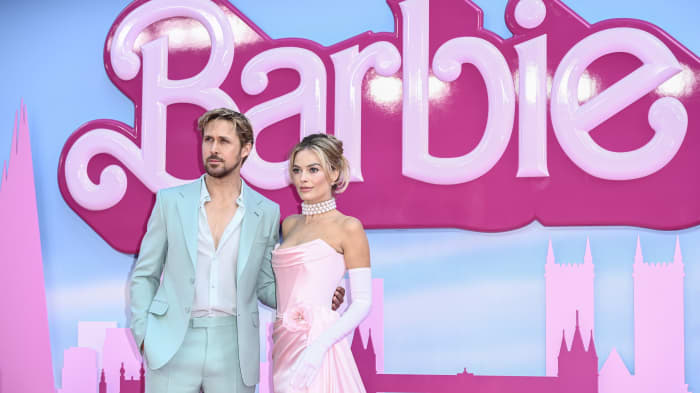This post was originally published on this site
Call it a “Barbie” bonanza: Margot Robbie, the star of the blockbuster film, is in line for a $50 million payday, according to a report from Variety.
But while that is certainly good news for the 33-year-old, Australian-born actress, it doesn’t seemingly change one harsh reality for women in Hollywood — namely, the fact that they generally make far less money than their male counterparts.
“There is a wage gap that persists through time,” said Sofia Izquierdo Sanchez, a senior lecturer in economics at England’s University of Manchester.
Sanchez has studied the issue in the film industry — she and a fellow researcher did a detailed analysis of what more than 250 actors were paid — and she told MarketWatch that the gap between men and women in Hollywood is “not converging at the same rate” as it is in other industries,
Consider that in a 2022 analysis by Insider of Hollywood’s 27 biggest all-time paydays, just three women made the list: Sandra Bullock ($70 million for “Gravity”), Cameron Diaz ($42 million for “Bad Teacher”) and Emma Stone ($26 million for “La La Land”). And as impressive as Robbie’s $50 million take may seem, it still puts the actress far behind Tom Cruise, who took home $100 million-plus for “Top Gun: Maverick,” and Will Smith, who made $100 million for his work in “Men in Black 3,” among other top earners.
There have also been notorious stories of pay discrepancies between men and women appearing in the same film. One of the most noted examples: Michelle Williams reportedly earned less than $1,000 for her work reshooting scenes in the 2017 film “All the Money in World” (yes, an ironic title given the situation); by contrast, her costar, Mark Wahlberg, made $1.5 million for the equivalent reshooting work.
Williams testified to Congress in 2019 about the situation, saying, “This came as no surprise to me, it simply reinforced my life-learned belief that equality is not an inalienable right.”

Margot Robbie (right) and her “Barbie” co-star Ryan Gosling attend the European Premiere of the film in London on July 12, 2023.
Gareth Cattermole/Getty Images
Other prominent actresses have expressed similar frustrations. Last year, Jennifer Lawrence, who reportedly earned $5 million less than her co-star Leonardo DiCaprio for her work in the 2021 film “Don’t Look Up,” told Vogue: “It doesn’t matter how much I do. I’m still not going to get paid as much as that guy, because of my vagina?”
Of course, the gender pay-gap issue is hardly unique to Hollywood, even if the film industry is often held up as among the worst examples of wage inequality.
An analysis by the American Association of University Women (AAUW) of 2021 government data found that women took home 77 cents for every dollar that men earned. When the data was adjusted to reflect full-time, year-round workers, the gap converged slightly — from 77 to 84 cents — but the disparity still equates to a big financial hit in the long run, said AAUW Chief Executive Officer Gloria L. Blackwell.
“Over the course of a lifetime, the pay gap causes women to lose out on billions of dollars in earnings,” she told MarketWatch.
Blackwell doesn’t take the situation in the film industry lightly, however, and sees it as symbolic of larger problems.
“The gender pay gap has always existed in Hollywood because the power gap in Hollywood has long been gendered and systemic. It mirrors the chronic undervaluing of women’s work throughout myriad sectors across our workforce and economy,” she said.
So, how can the gap in Hollywood, much less in the workforce as a whole, be erased? Sanchez said that pay transparency is one key solution — that is, the more that women in the film industry know about who’s earning what, then the better position they will be in to negotiate higher paydays.
And if women can close the gap in Hollywood, Sanchez said it can have a ripple effect throughout society: “The film industry is an important cultural industry which has a big influence on the population.”
Blackwell said women in Hollywood also have to “create their opportunities” when possible.
“Many have formed their own production companies and developed their own projects,” she said, pointing to Shonda Rhimes, Reese Witherspoon and Kerry Washington as key examples.
Still, the clear burden is on the Hollywood studios to effect change, Blackwell said: “Like any other de facto employer, [they] must examine pay disparities among costars and rectify those disparities. If a man and a woman have top billing, her pay should not be a mere fraction of his.”
In the case of “Barbie,” Variety reported that Robbie’s co-star, Ryan Gosling, who plays Ken, took home $12.5 million for his work — the same upfront figure that Robbie got. But Robbie’s pay ballooned because of box-office bonuses, according to Variety, which didn’t indicate if Gosling stands to collect similar backend money.
Variety did say, however, that Greta Gerwig, the film’s director, “will also likely receive bonuses because of the film’s outsized success.” The picture has grossed more than $1 billion to date.
Blackwell said Robbie’s $50 million payday makes her a clear “outlier” among women in the film industry.
“Hopefully her success will create more opportunities for other women in Hollywood,” she said.


